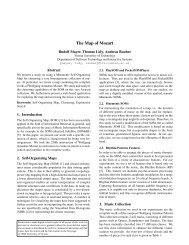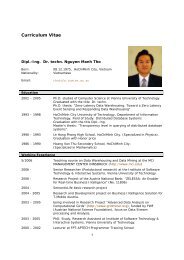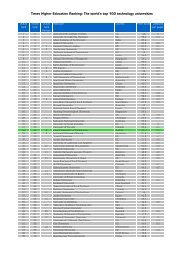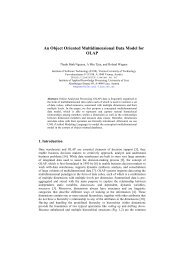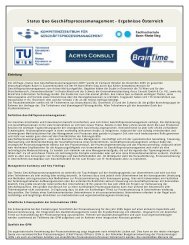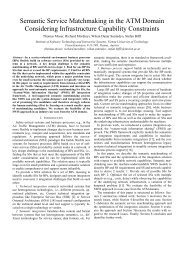Using Psycho-Acoustic Models and Self-Organizing Maps to Create ...
Using Psycho-Acoustic Models and Self-Organizing Maps to Create ...
Using Psycho-Acoustic Models and Self-Organizing Maps to Create ...
You also want an ePaper? Increase the reach of your titles
YUMPU automatically turns print PDFs into web optimized ePapers that Google loves.
“<br />
À<br />
‘<br />
<strong>Using</strong> <strong>Psycho</strong>-<strong>Acoustic</strong> <strong>Models</strong> <strong>and</strong> ¢¡¤£¦¥ <strong>to</strong> create a Hierarchical Structuring of Music<br />
†J‡S‰.ŠF‹Œ1{<br />
‡y˜.š}|<br />
<br />
˜ ž<br />
ŒË¡ ‹‰'Œ"‹u’vŠ ‡Aj˜=¡y¡yŒ"<br />
‡yŒ"Œ<br />
mlu¾ËŽ<br />
¦¢²(~c—<br />
some branches of this map, <strong>and</strong> compare them <strong>to</strong> the respective areas<br />
in the mNp{`FaNb of the smaller data collection depicted in Figure 7<br />
Generally, we find pieces of soft classical music in the upper right<br />
corner, with the music becoming gradually more dynamic <strong>and</strong> aggressive<br />
as we move <strong>to</strong>wards the bot<strong>to</strong>m left corner of the map.<br />
Due <strong>to</strong> the characteristics of the training process of the mNp{`FaNb<br />
we can find the same general tendency at the respective lower-layer<br />
maps. The overall orientation of the map hierarchy is rotated when<br />
compared <strong>to</strong> the smaller mNp{`FaNb , where the classical titles were<br />
located in the bot<strong>to</strong>m right corner, with the more aggressive titles<br />
placed on the upper left area of the map. This rotation is due <strong>to</strong><br />
the unsupervised nature of mNp¤`5aNb the training process. It can,<br />
however, be avoided by using specific initialization techniques if a<br />
specific orientation of the map were required.<br />
The unit in the upper right corner of the <strong>to</strong>p-layer map, representing<br />
the softest classical pieces of music, is exp<strong>and</strong>ed on<strong>to</strong> a FZîj§ map<br />
in the second layer (exp<strong>and</strong>ed <strong>to</strong> the upper right in Figure 8). Here<br />
we again find the softest, most peaceful pieces in the upper right<br />
corner, namely part of the sound-track of the movie [Q\ {‚ \ ,<br />
next <strong>to</strong> ¹F_C´AgQou‚ \ ~ by ¬ _:¢px \ g._ \<br />
,<br />
« h¢_^bc_ \:\ }u‚ˆ_C:g¢~<br />
by `'h [Q¬ gsg , <strong>and</strong> ¨0g=g by ‚Rh¢_$©k_$© . Below this unit we find<br />
further soft titles, yet somewhat more dynamic. We basically find<br />
all titles that were mapped <strong>to</strong>gether in the bot<strong>to</strong>m right corner unit<br />
of the smaller collection depicted in Figure 7 on<br />
of mNp¤`5aNb the<br />
this unit, uJ \ µ-uJ´_…bv \ µNXZY [Q\x] © A$_:µX \ _ ¬ i_¢¹ Y g'i_ \ [ g=i<br />
i.e.<br />
i:_:g._ ¯<br />
<strong>and</strong> the bvg'i:h¢_:Ag¢:g'~7_ . Furthermore,<br />
bc_:gs:h¢_:ģ<br />
a few additional titles of the larger collection have been mapped<br />
on<strong>to</strong> this unit, the most famous of which probably Æx*_¢©t_:Ag=_<br />
€<br />
are<br />
¬^[ S by bv \ ~ , the X [ g._ \ ©0bv \ h by ¨Fhs:w'yg or the<br />
RhQ~<br />
iRo from the Clarinet Concert by emphMozart.<br />
û<br />
Let us now take a look at the titles that were mapped on<strong>to</strong> the<br />
neighboring units in the previously presented smaller data collection.<br />
The d \ g'i_:g=k [Q\ oA:h¢_x^g9_ \ ~7_ , located on the neighboring unit<br />
<strong>to</strong> the right in the first example, can be found in the lower left corner<br />
of this map, <strong>to</strong>gether with, for u|© :zw \ RhzO \ ~yh [ ~ \ <br />
example,<br />
hs \ i^`¢~ \ [ƒ‚<br />
by . Mapped on<strong>to</strong> the upper neighboring unit in the<br />
mNp{`FaNb smaller we had titles like X0 \ ~=bv´_ ¬ _:gs~OLrN~yh¢_q~yh<br />
the<br />
¬ wshsgs} by d{__:~yhs´_:g , or the « ~*ug'i¢X [ o_xyguÆ bËyg= \<br />
`s}<br />
d|h by . We find these two titles in the upper left corner of the<br />
2-layer map of mNp¤`5aNb this , <strong>to</strong>gether with two of the three titles<br />
mapped on<strong>to</strong> the diagonally neighboring unit in the mNp{`Fa0b first ,<br />
¹4´_ ¬ _ « _:g'i_ \<br />
i.e. by © ´A{‚ \ _:©t_:} , <strong>and</strong> « h¢_…ˆ_ by d{_:~~7_<br />
]<br />
\<br />
, which are again soft, mellow, but a bit more dynamic. The<br />
b¦is©t_<br />
third title mapped on<strong>to</strong> this unit in the m0p¤`5aNb smaller , i.e. the<br />
sound track of the d|j~*j~yh¢_^X [ ~ [Q\ _<br />
movie is not mapped<br />
in<strong>to</strong> this branch of this mNp{`Fa0b<br />
anymore. When we listen <strong>to</strong> this<br />
title we find it <strong>to</strong> have mainly strong orchestral parts, which have a<br />
different, more intense sound than the soft pieces mapped on<strong>to</strong> this<br />
branch, which is more specific with respect <strong>to</strong> very soft classical titles<br />
as more of them are available in the larger data collection. Instead,<br />
we can find this title on the upper right corner in the neighboring<br />
branch <strong>to</strong> the left, originating from the upper left corner unit of the<br />
<strong>to</strong>p-layer map. There it is mapped <strong>to</strong>gether with « h¢_…d|_ [ ~}qg'i<br />
<strong>to</strong> be more or<br />
less identical <strong>to</strong> the overall organization of the mNp{`FaNb<br />
smaller in<br />
so far as the titles present in both collections are mapped in similar<br />
relative positions <strong>to</strong> each other.<br />
<strong>and</strong> other orchestral pieces, such as u|©A©t_o \ ubv© ~* by<br />
~yhs_ƒd{_C~<br />
\ 9h ¬ . We thus find this branch of the mNp¤`5aNb<br />
d<br />
Due <strong>to</strong> the <strong>to</strong>pology preservation provided by mNp{`FaNb the we can<br />
move from the soft classical cluster map <strong>to</strong> the left <strong>to</strong> find somewhat<br />
more dynamic classical pieces of music on the neighboring map<br />
(exp<strong>and</strong>ed <strong>to</strong> the left in Figure 8). Thus, a typical disadvantage of<br />
hierarchical clustering <strong>and</strong> structuring of datasets, namely the fact<br />
that a cluster that might be considered conceptually very similar is<br />
subdivided in<strong>to</strong> two distinct branches, is alleviated in mNp{`Fa0b the<br />
concept, because these data points are typically located in the close<br />
neighborhood. We thus find, on the right border of the neighboring<br />
map, the more peaceful titles of this branch, yet more dynamic than<br />
the classical pieces on the neighboring right branch discussed above.<br />
KtKtK<br />
‘¼


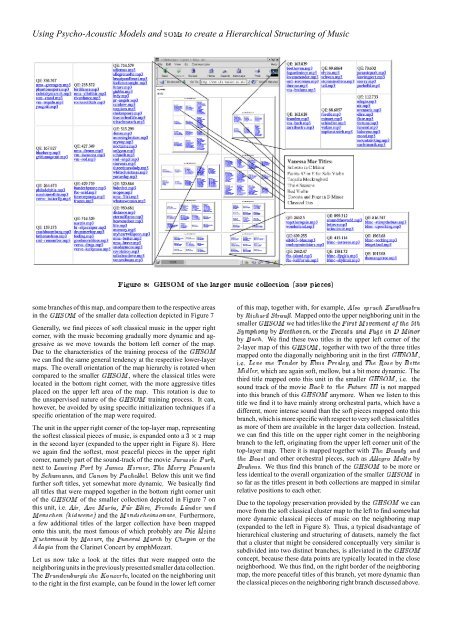



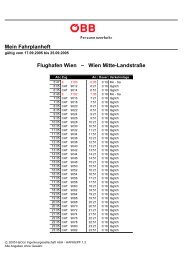
![Informationsvisualisierung [WS0708 | 01 ]](https://img.yumpu.com/22537403/1/190x143/informationsvisualisierung-ws0708-01-.jpg?quality=85)
